Energies of Mechanical Fractional-Order Elements: Causal Concept and Kernel Effects
Abstract
:1. Introduction
1.1. Aim
1.2. Textual Organization
2. Lorenzo–Hartley Concept: A Thorough Evaluation and New Causal Interpretation
2.1. Force–Displacement Relationship: Non-Causal Formulation
2.2. Force–Displacement Relationship: Causal Formulation
2.3. Energy of Mechanical Elements
2.4. Two Examples from Lorenzo and Hartley
2.4.1. Unit Step Force
2.4.2. Ramp Force
2.5. Recovered Energy following Lorenzo and Hartley
2.6. Effect of the Initialization following Lorenzo and Hartley [6]
3. Causality in Dynamic Laws
3.1. The Philosophical Foundations of Cause and Effect
- Causa materialis, i.e., material causes encountered in the reactions of chemical elements or as response to the exertion of mechanical force, are the basic laws involved in the lives of plants and animals.
- Causa efficiens, i.e., efficient causes, explain the drivers (causes of motion) during the process from the initial to the final state.
- Causa finalis, i.e., final causes, can be explained by the simple question “why?”. Hence, we need to specify the motivation of change from the initial towards the final state, that is, the reason for change.
- The causal relation must be asymmetric, that is, the asymmetry of the causal relation indicates its irreflexivity, stressing the fact that no element is related to itself, i.e., the cause cannot match the effect caused by it.
- Concerning time relations, it follows that the cause and effect do not happen simultaneously, that is, there is always a time shift between them. This refers to the reality that no phenomena develop with infinite speed and there are no sources of energies with infinite power.
3.2. Mathematical Models of Dynamic Systems with Respect to Causality
- Initial stage, when the incoming particles are moving towards one another. Their interaction can be neglected, as the distances between them are sufficiently larger than their free paths.
- Intermediate stage, when the particles are closer together and the distances between them are less than the free parts, resulting in interactions between the particles.
- Final stage, when the particles leave the contact domain and the distances between them allow them to again be considered as non-interacting.
- C1.
- Primitive causality: the effect cannot precede the cause. In such situations, the cause and effects should be correctly defined.
- C2.
- Relativistic causality: no signal can propagate with a velocity greater than the speed of light in the vacuum; this can be considered as a macroscopic causality condition.
- Linearity: the system obeys the superposition principle in its simple version, implying that the output is a linear functional of the inputwhere , , and may represent distributions.
- Time-translation invariance: a system is time-translation invariant if the input is shifted (forward or backward) by some time interval and corresponds to . In this case, the function should depend only on the difference between the arguments, that is, , and the linear functional can be expressed asThe relation (34) is a convolution between the input (cause) and the output (effect) ; the correlation function (called the memory or kernel) allows us to model the time shift, i.e., the output at time corresponding to an earlier moment of the input .
- Primitive causality condition: the input cannot precede the output; therefore, the input vanishes for , meaning that the same is valid for . Thus, without loss of generality, T can be assumed to be zero (i.e., the moment when the input is applied). Consequently, we obtain if .
4. New Examples with the Riemann–Liouville Integral as a Force–Displacement Relationship
4.1. Power-Law Force Ramp
4.2. Polynomial Force Ramp
4.3. Exponential Force Ramp
Exponential Force Ramp: Energy
4.4. Ramp Force Approximated by Prony Series
4.5. Outcomes from the Examples Solved through the Riemann–Liouville Fractional Integral
5. More General Formulations of the Causal Force–Displacement Relationship
5.1. Fractional Element with Exponential Memory
5.1.1. General Power-Law Force to the Element with Exponential Memory
5.1.2. Exponential Force to the Element with Exponential Memory
5.1.3. Refining the Integral Force–Displacement Relationship
5.1.4. Multi-Exponential Memory (Prony’s Series)
5.2. Fractional Element with Mittag-Leffler Memory
5.2.1. Unit Step Force
5.2.2. Linear Ramp Force
5.2.3. Power-Law Ramp Force
5.3. Fractional Element with Prabhakar Memory
5.3.1. Unit Step Force
5.3.2. Linear Ramp Force
5.3.3. An Example of the Use of the Complete Prabhakar Function
5.4. Outcomes from the Examples Solved through Convolution Integrals with Memories Different from the Power Law
6. Final Comments
6.1. Outline of Main Achievements
6.2. Emergent Problems
6.3. Ideas Drawing New Problems
- (a)
- Development of causal fractional modeling towards other mechanical models used in linear viscoelasticity.
- (b)
- Causal modeling of both linear and nonlinear electrical circuits, where the current–tension relationships closely resemble the force–displacement formulations covered here.
- (c)
- Causal fractional modeling of dissipative transport phenomena, where the flux-driving force or flux potential can be modeled by convolution integral relationships.
7. Conclusions
Funding
Data Availability Statement
Conflicts of Interest
Appendix A. The Causal Second Newton’s Law: A Point of View
Appendix A.1. A Motion Caused by an Exerted Force
Appendix A.2. A Force Caused by the Impact of a Moving Body on an Object
Appendix B. Properties of Functions Related to the Used Relaxation Kernels
Appendix B.1. Mittag-Leffler Function
Appendix B.1.1. Mittag-Leffler Function (One Parameter)
Appendix B.1.2. Mittag-Leffler Function (Two Parameters)
Appendix B.1.3. Mittag-Leffler Function (Three Parameters)
Appendix B.2. Prabhakar Function
References
- Findley, W.N.; Lai, J.S.; Onaran, K. Creep and Relaxation of Nonlinear Viscoelastic Materials; North Nolland Publishing: Amsterdam, The Netherlands, 1976. [Google Scholar]
- Koeller, R.C. Application of fractional calculus to the theory of viscoelasticity. J. Appl. Mech. 1984, 51, 299–307. [Google Scholar] [CrossRef]
- Friedrich, C. Relaxation and retardation functions of the Maxwell model with fractional derivatives. Rheol. Acta 1991, 30, 151–158. [Google Scholar] [CrossRef]
- Heymans, N.; Bauwens, J.C. Fractal rheological models and fractional differential equations for viscoelastic behavior. Rheol. Acta 1994, 33, 210–219. [Google Scholar] [CrossRef]
- Lion, A. On the thermodynamics of fractional damping elements. Continum Mech. Thermodyn. 1997, 9, 83–96. [Google Scholar] [CrossRef]
- Lorenzo, C.F.; Hatley, T.T. Energy considerations for mechanical fractional-order elements. J. Comp. Nonlinear Dynam. 2015, 10, 011014. [Google Scholar] [CrossRef]
- Podlubny, I. Fractional Differential Equations; Academic Press: New York, NY, USA, 1999. [Google Scholar]
- Hristov, J. Constitutive fractional modeling. In Mathematical Modeling: Principle and Theory; Dutta, H., Ed.; AMS Series “Contemporary Mathematics”; American Mathematical Society: Providence, RI, USA, 2023; Volume 786, pp. 37–140. [Google Scholar] [CrossRef]
- Hristov, J. The fading memory formalism with Mittag-Leffler-type kernels as a generator of non-local operators. Appl. Sci. 2023, 13, 3065. [Google Scholar] [CrossRef]
- Mittelstaedt, P.; Weingartner, P.A. Laws of Nature; Springer: Berlin/Heidelberg, Germany, 2005. [Google Scholar]
- Nussenzveig, H. Causality and Dispersion Relations; Mathematics in Science and Engineering; Academic Press: New York, NY, USA, 1972; Volume 95. [Google Scholar]
- Nutting, P.G. A new general law of deformation. J. Franklin Inst. 1921, 191, 679–685. [Google Scholar] [CrossRef]
- Nutting, P.G. Deformation in relation to time, pressure and temperature. J. Franklin Inst. 1946, 242, 449–458. [Google Scholar] [CrossRef]
- Scott-Blair, G.W.; Reiner, M. The rheological law underlying the Nutting equation. Appl. Sci. Res. 1951, A2, 225–234. [Google Scholar] [CrossRef]
- Hartley, T.T.; Trigeassou, J.-C.; Lorenzo, C.F.; Maamry, N. Energy storage and loss in fractional-order systems. J. Comput. Nonlinear Dynam. 2015, 10, 061006. [Google Scholar] [CrossRef]
- Hartley, T.T.; Lorenzo, C.F. The initialization response of linear fractional-order systems with constant history function. In Proceedings of the ASME 2009 International Design Engineering Technical Conferences and Computers and Information in Engineering Conference. Volume 4: 7th International Conference on Multibody Systems, Nonlinear Dynamics, and Control, Parts A, B and C, San Diego, CA, USA, 30 August–2 September 2009; ASME: New York, NY, USA, 2009; pp. 1327–1332. [Google Scholar] [CrossRef]
- Malti, R.; Cois, O.; Aoun, M.; Levron, F.; Oustaloup, A. Energy of fractional order transfer functions. IFAC Proc. Vol. 2002, 35, 449–454. [Google Scholar] [CrossRef]
- Hilfer, R. Fractional Time evolution. In Applications of Fractional Calculus in Physics; Hilfer, R., Ed.; World Scientific: Singapore, 2000; pp. 89–116. [Google Scholar]
- Knopp, K. Theory and Application of Infinite Series; Hafner: New York, NY, USA, 1928. [Google Scholar]
- de Prony, G.R. Essai Experimentale at analitique. J. Ecole Polytech. 1795, 1, 24–76. [Google Scholar]
- Mauro, J.C.; Mauro, Y.Z. On the Prony representation of stretched exponential relaxation. Phys. A 2018, 506, 75–87. [Google Scholar] [CrossRef]
- Mandelbrot, S. Dirichlet Series: Principle and Methods; D. Reidel Publishing Co.: Dordrecht, The Netherlands, 1972. [Google Scholar]
- Titchmarsh, E.C. Introduction to the Theory of Fourier Integrals, 2nd ed.; Clarendon Press: Oxfors, UK, 1948. [Google Scholar]
- Watson, E.J. Laplace Transforms and Applications; Van Nostrand Reinholt Co.: New York, NY, USA; London, UK, 1981. [Google Scholar]
- Srivastava, H.M.; Buschman, R.G. Theory and Applications of Convolution Integral Equations; Springer: Dordrecht, The Netherlands, 1992. [Google Scholar]
- Coleman, B.; Noll, W. Foundations of linear Viscoelasticity. Rev. Mod. Phys. 1961, 33, 239–249. [Google Scholar] [CrossRef]
- Pipkin, A.C. Lectures on Viscoelasticity Theory, 2nd ed.; Sprimger: New York, NY, USA, 1972. [Google Scholar]
- Garbarski, J. The application of an exponentially-type function for the modeling of viscoelasticity of solid polymers. Polym. Eng. Sci. 1992, 32, 107–114. [Google Scholar] [CrossRef]
- Tschoegl, N.W. The Phenomenological Theory of Linear Viscoelastic Behaviour: An Introduction; Springer: New York, NY, USA, 1989. [Google Scholar]
- Hristov, J. Linear viscoelastic responses and constitutive equations in terms of fractional operators with non-singular kernels: Pragmatic approach, Memory kernel correspondence requirement and analyses. Eur. Phys. J. Plus 2019, 134, 283. [Google Scholar] [CrossRef]
- Widder, D.V. An Introduction to Transform Theory; Academic Press: New York, NY, USA, 1971. [Google Scholar]
- Hristov, J. Derivatives with non-singular kernels: From the Caputo-Fabrizio definition and beyond: Appraising analysis with emphasis on diffusion models. In Frontiers in Fractional Calculus; Bhalekar, S., Ed.; Bentham Science Publishers: Sharjah, United Arab Emirates, 2018; pp. 269–342. [Google Scholar]
- Caputo, M.; Fabrizio, M. A new definition of fractional derivative without singular kernel. Prog. Fract. Differ. Appl. 2015, 1, 73–85. [Google Scholar]
- Caputo, M.; Fabrizio, M. Applications of new time and spatial fractional derivatives with exponential kernels. Prog. Fract. Differ. Appl. 2016, 2, 1–11. [Google Scholar] [CrossRef]
- Adolfsson, K.; Enelund, M.; Olsson, P. On the fractional order model of viscoelasticity. Mech. Time-Depend. Mater. 2005, 9, 15–34. [Google Scholar] [CrossRef]
- Enelund, M.; Lesieutre, G.A. Time domain modeling of damping using anelastic displacement fields and fractional calculus. Int. J. Solids Struct. 1999, 36, 4447–4472. [Google Scholar] [CrossRef]
- Zhou, H.W.; Wang, C.P.; Han, B.B.; Duan, Z.Q. A creep constitutive model for salt rock based on fractional derivatives. Int. J. Rock Mech. Min. Sci. 2016, 48, 116–121. [Google Scholar] [CrossRef]
- Alsaedi, A.; Nieto, J.J.; Venktesh, V. Fractional electrical circuits. Adv. Mech. Eng. 2015, 7, 1–7. [Google Scholar] [CrossRef]
- Baleanu, D.; Golmankhaneh, A.K.; Golmankhaneh, A.K.; Nigmatulin, R.R. Newtonian law with memory. Nonlinear Dyn. 2010, 60, 81–96. [Google Scholar] [CrossRef]
- Mainardi, F. On some properties of the Mittag-Leffler function Eα(-tα) completely monotone for t > 0 with 0 < α < 1. Discret. Contin. Dyn. Syst. B 2014, 19, 2267–2278. [Google Scholar] [CrossRef]
- Kilbas, A.A.; Saigo, M.; Saxena, R.K. Generalized Mittag-Leffler function and generalized fractional calculus operators. Integral Trasforms Spec. Funct. 2004, 15, 31–49. [Google Scholar] [CrossRef]
- Prabhakar, T.R. A singular integral equation with a generalized Mittag-Leffler function in the kernel. Yokohama Math. J. 1971, 19, 7–15. [Google Scholar]
- Mainardi, F.; Garrappa, R. On complete monotonicity of the Prabhakar function and non-Debye relaxation in dielectrics. J. Comp. Phys. 2015, 293, 70–80. [Google Scholar] [CrossRef]
- Giusti, A.; Colombaro, I.; Garra, R.; Garrappa, R.; Polito, F.; Popolizio, M.; Mainardi, F. A practical guide to Prabhakar fractional calculus. Frac. Calc. Appl. Anal. 2020, 23, 9–54. [Google Scholar] [CrossRef]
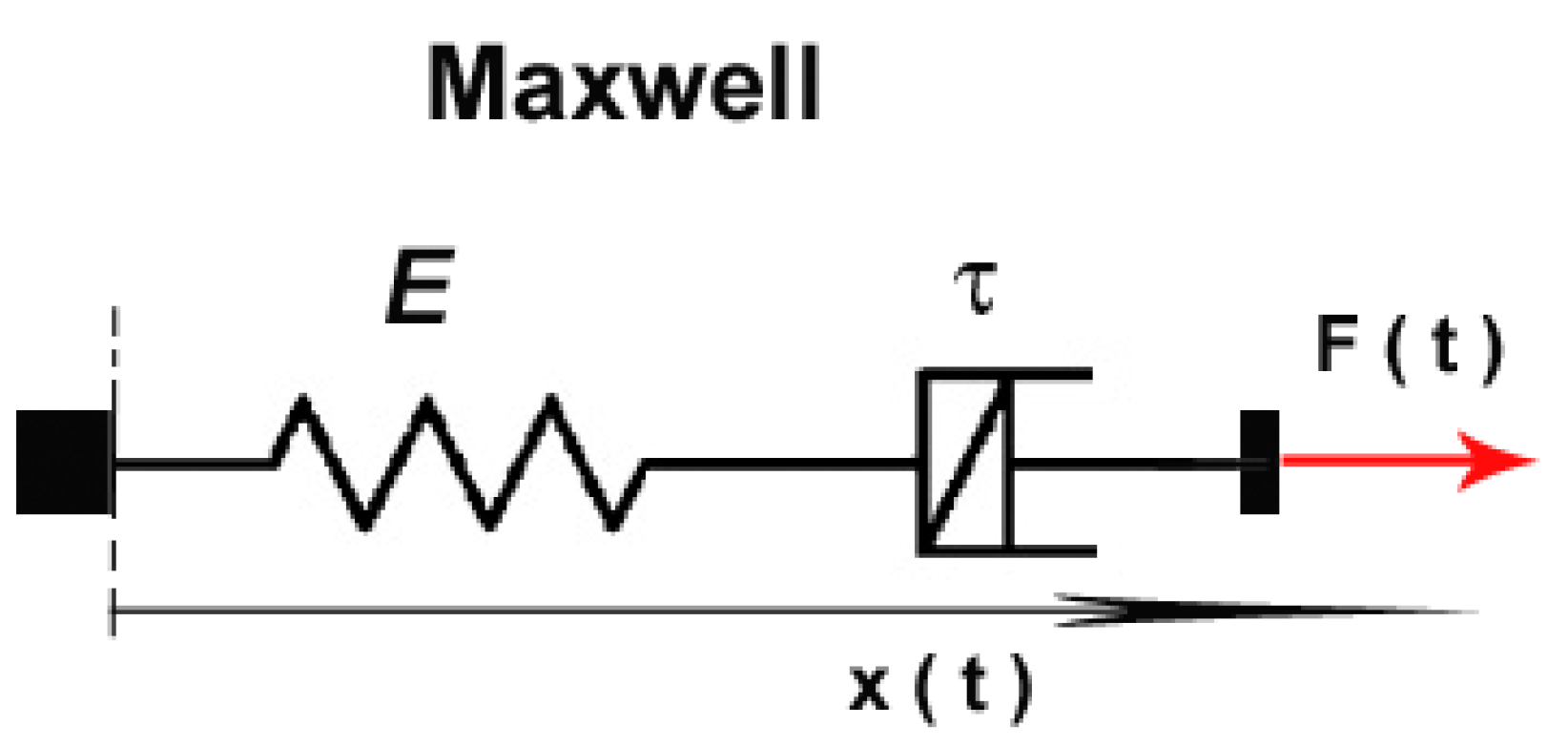

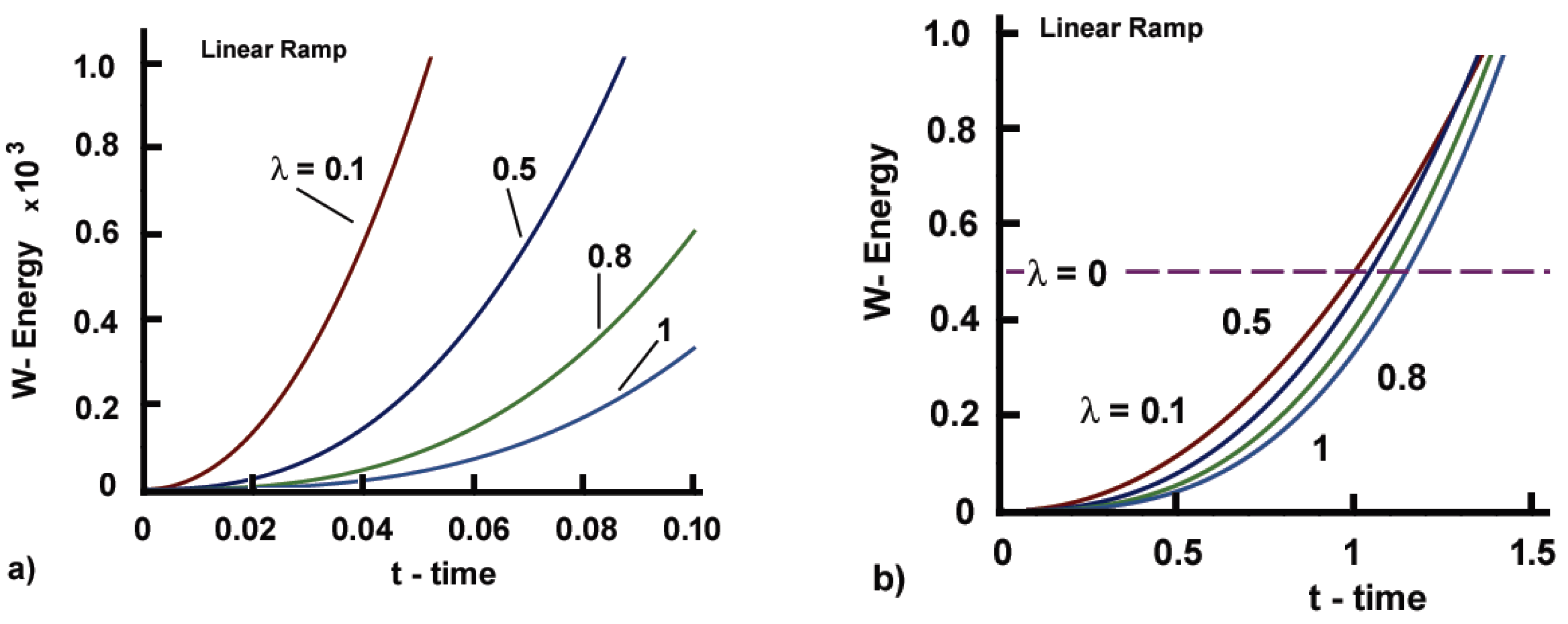
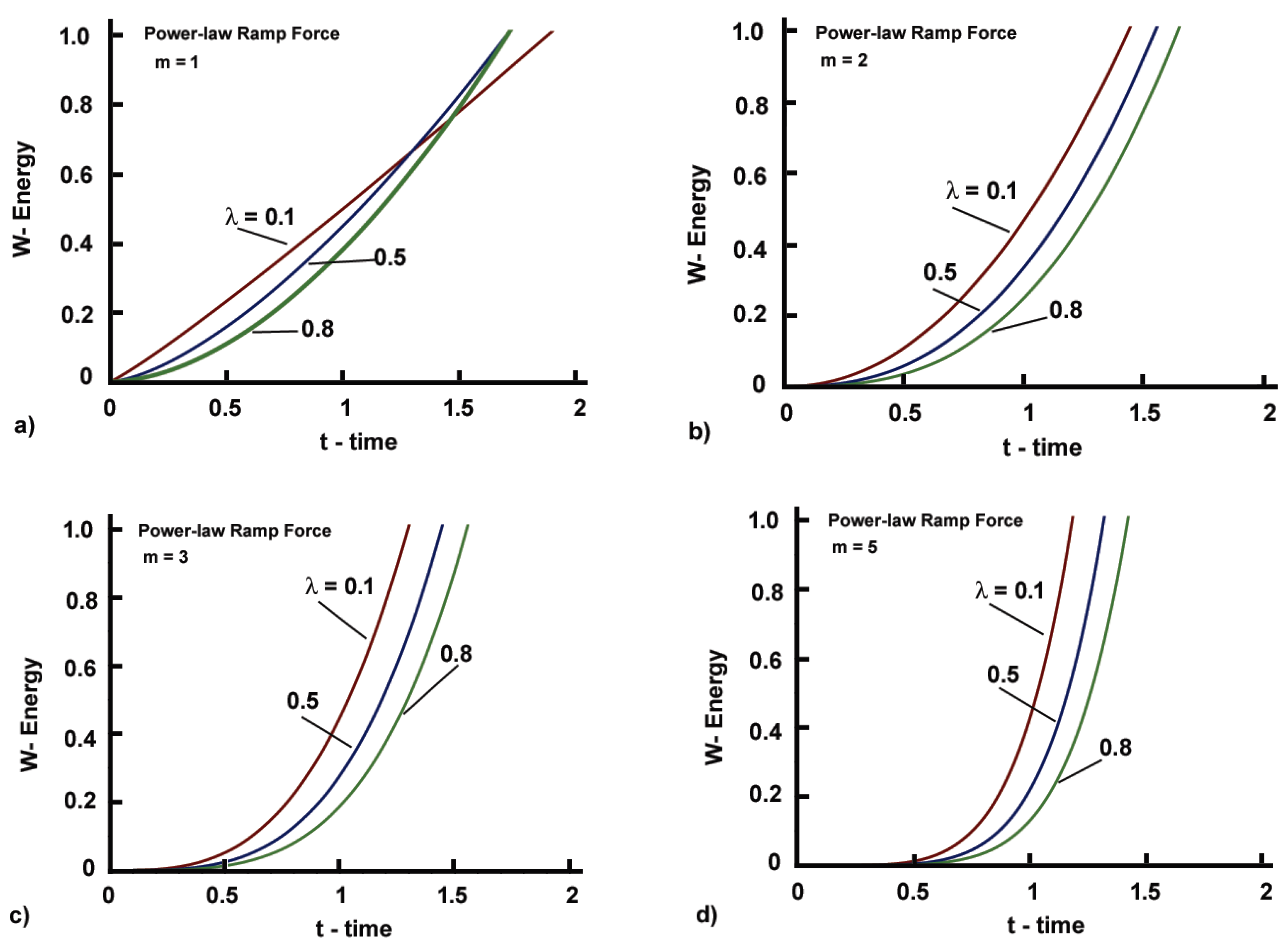
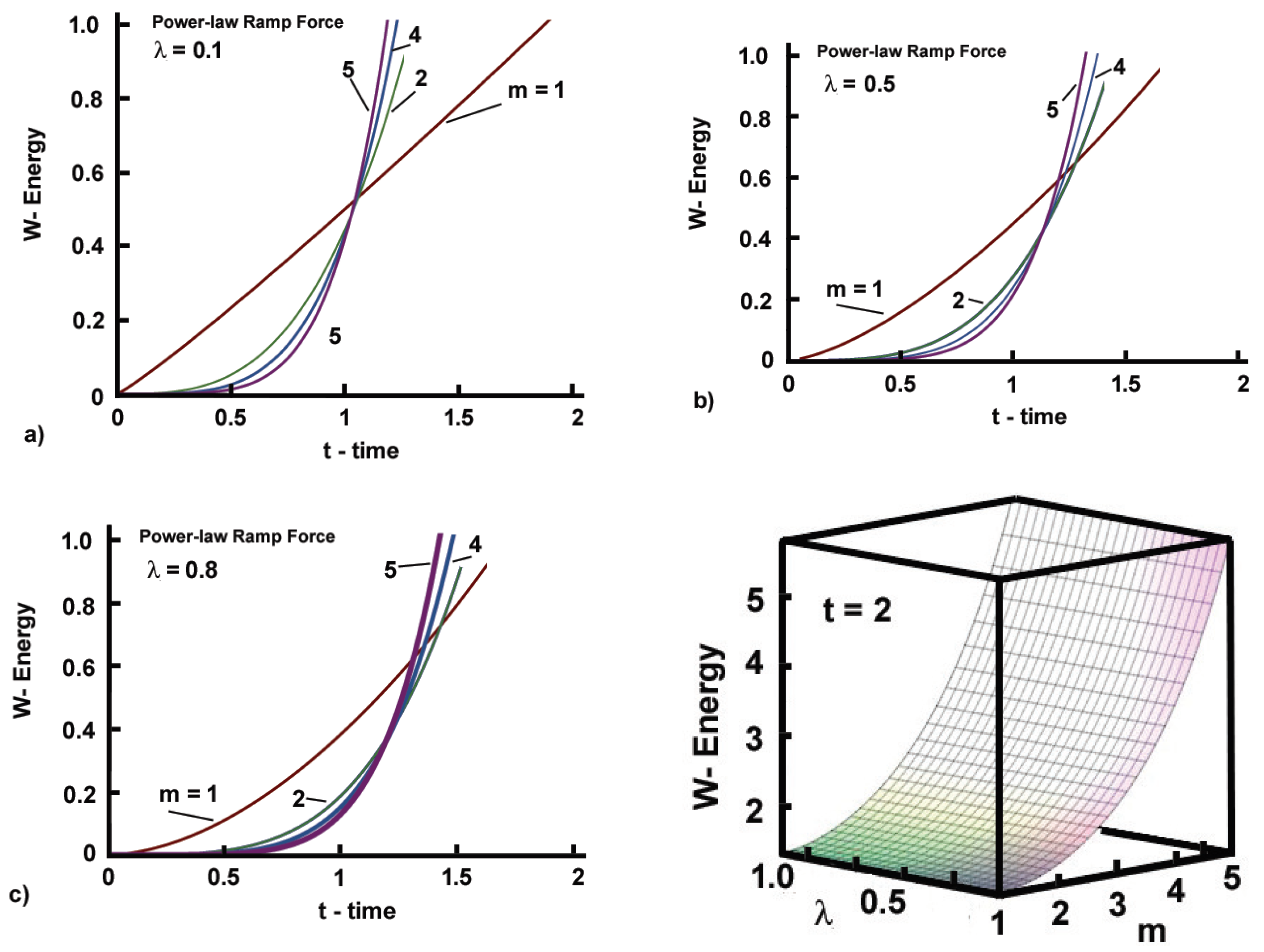
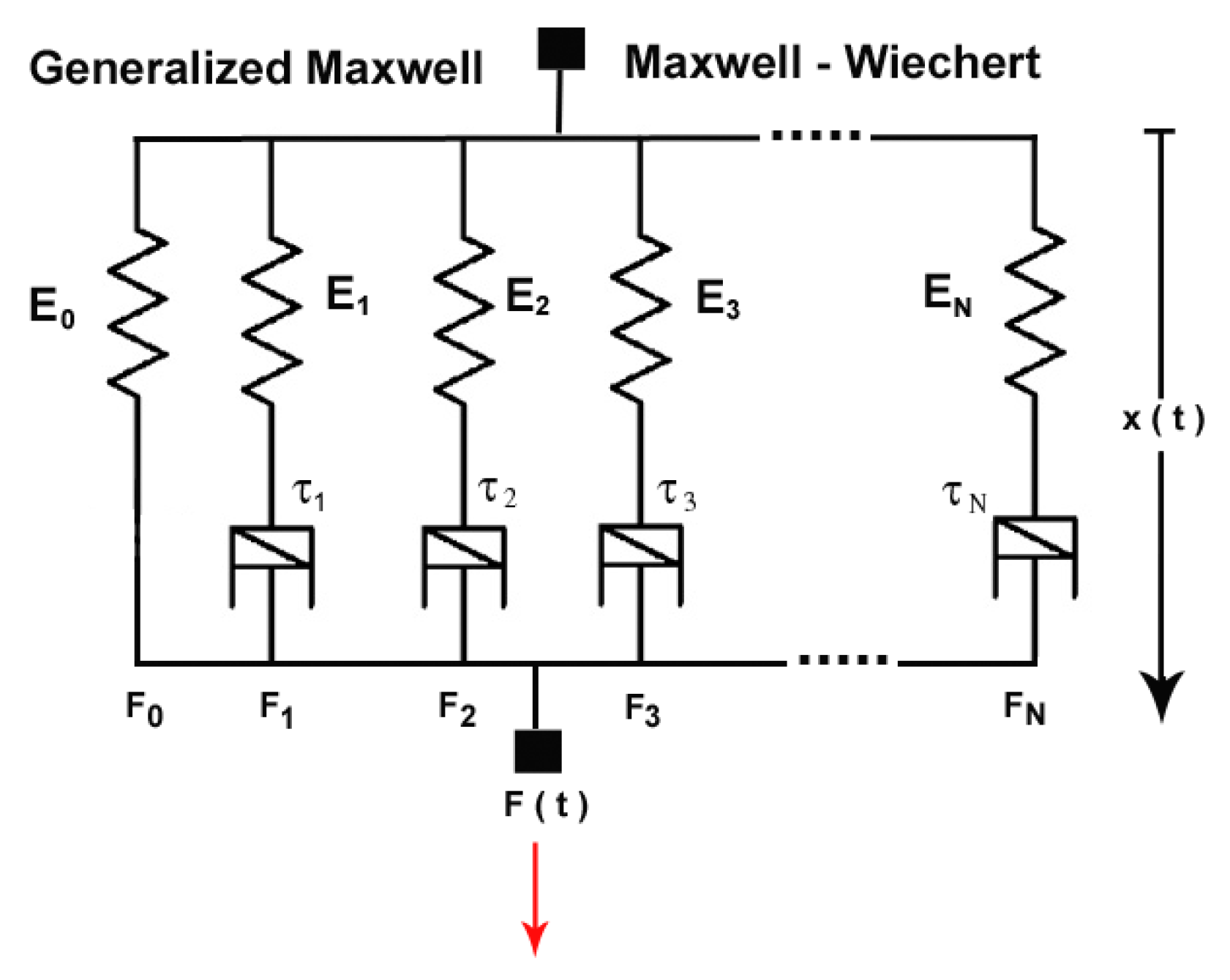
Disclaimer/Publisher’s Note: The statements, opinions and data contained in all publications are solely those of the individual author(s) and contributor(s) and not of MDPI and/or the editor(s). MDPI and/or the editor(s) disclaim responsibility for any injury to people or property resulting from any ideas, methods, instructions or products referred to in the content. |
© 2023 by the author. Licensee MDPI, Basel, Switzerland. This article is an open access article distributed under the terms and conditions of the Creative Commons Attribution (CC BY) license (https://creativecommons.org/licenses/by/4.0/).
Share and Cite
Hristov, J. Energies of Mechanical Fractional-Order Elements: Causal Concept and Kernel Effects. Appl. Sci. 2024, 14, 197. https://doi.org/10.3390/app14010197
Hristov J. Energies of Mechanical Fractional-Order Elements: Causal Concept and Kernel Effects. Applied Sciences. 2024; 14(1):197. https://doi.org/10.3390/app14010197
Chicago/Turabian StyleHristov, Jordan. 2024. "Energies of Mechanical Fractional-Order Elements: Causal Concept and Kernel Effects" Applied Sciences 14, no. 1: 197. https://doi.org/10.3390/app14010197





